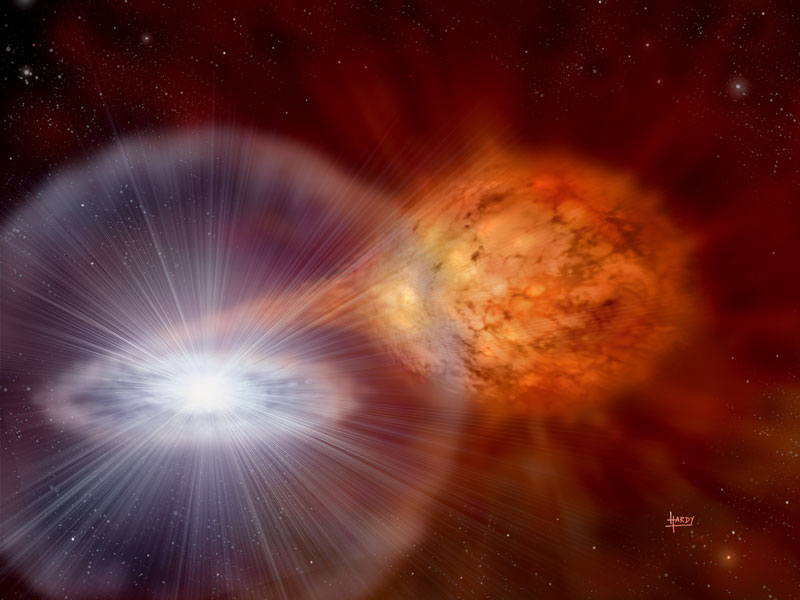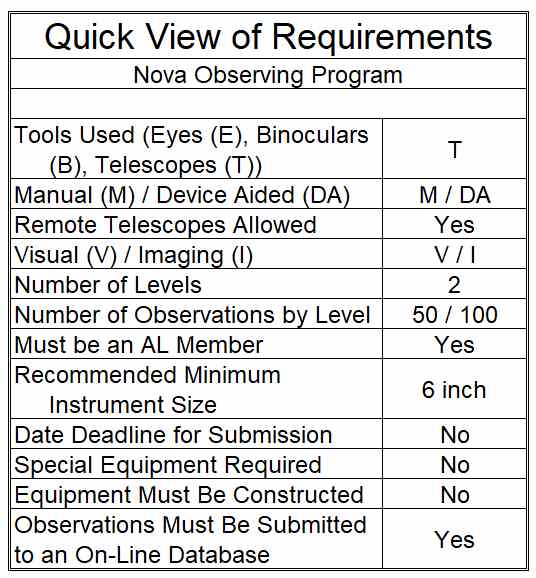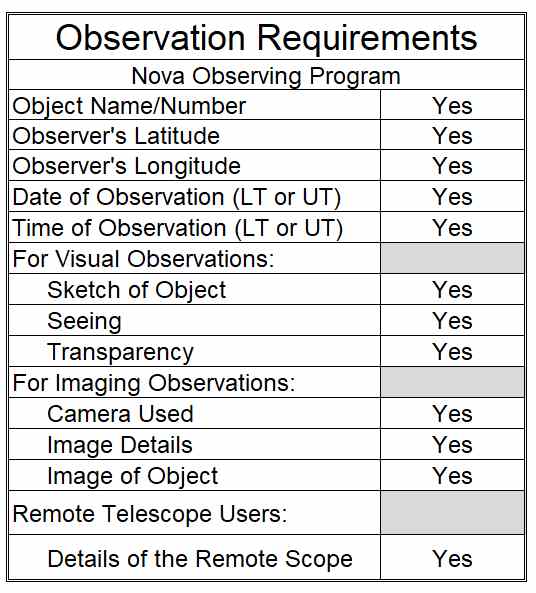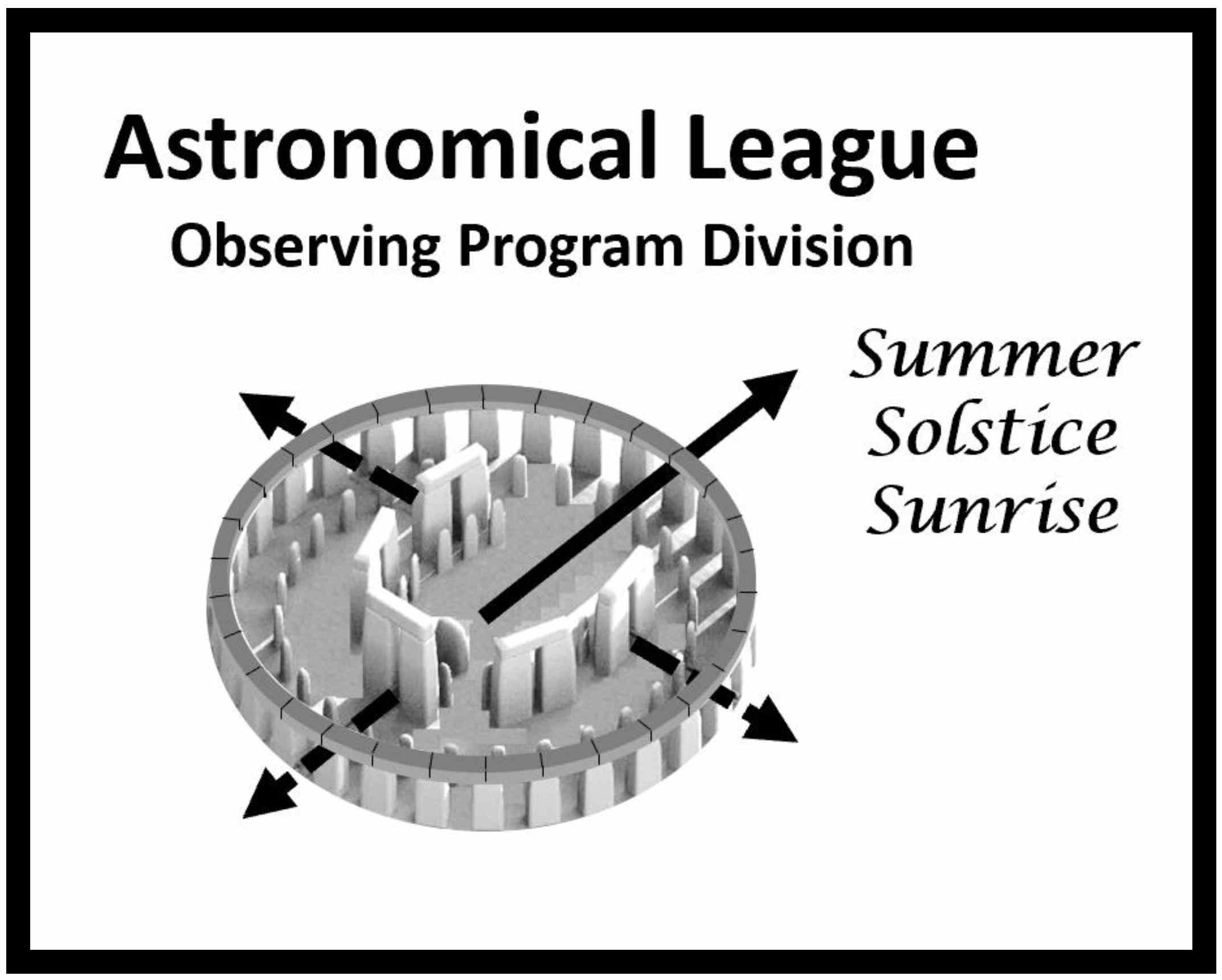Nova Observing Program Coordinator
|
 ©David A. Hardy, www.astroart.org, Used with permission. |
IntroductionWelcome to the Astronomical League’s Nova Observing Program, which encourages locating, observing, sketching and/or imaging of Novae, Supernovae, and Dwarf Novae. It involves the use of online resources of the American Association of Variable Star Observers (AAVSO) and provides valuable scientific data for astronomers and researchers. A Nova is caused by a nuclear explosion on the surface of a star within a binary star system, resulting in the sudden appearance of a “new” star which slowly fades over weeks or months. Novae are a fairly common occurrence within our galaxy. Some are recurrent, with many years between outbursts. They can appear anywhere in the sky but are most often discovered not far from the galactic center in Sagittarius. A Supernova occurs during the final stages of a massive star’s life, causing it to be destroyed in a final gigantic explosion. Supernovae are immensely bright, but much rarer than regular novae. In the Milky Way Galaxy, the last one directly observed was recorded in 1604 (known as Kepler’s Supernova). They are frequently seen to occur in nearby galaxies. Supernovae generate so much energy that they can briefly outshine their parent galaxies. A Dwarf Nova is a type of cataclysmic variable star, with lower luminosity than regular novae. Typically, a white dwarf primary star pulls material from a red dwarf secondary. This forms an “accretion disk” which then explodes, causing bright outbursts on a semi-regular basis. Examples of Dwarf Novae include U Gem, SS Cyg, Z Cam, SU UMa. Rarely, Dwarf Novae can erupt into full-fledged Novae, as V392 Per did in April 2018, becoming Nova Persei 2018. Novae, Supernovae, and Dwarf Novae can all become bright enough to be observed and/or imaged with amateur telescopes. Observations involve estimating the magnitude in comparison to ordinary stars of fixed brightness. For those amateurs with CCD equipment, photometric methods may be used to measure the intensity of the Nova. |
 |
Because most of the AAVSO procedures are the same, you are encouraged to pursue the Astronomical League’s Variable Star Observing Program concurrently while pursuing this Observing Program. The Nova Observing Program will require some patience, as opportunities for observing can be sporadic, especially for northern observers. On the other hand, you don’t need the darkest or clearest skies, or even a moonless night to observe many of the brighter Novae.
Pictured above is an artist’s conception of RS Ophiuchi, a recurring nova system that explodes to sudden brightness every 20 years or so. You’re encouraged to make RS Ophiuchi a part of your observing list, you may be lucky enough to catch an outburst! (Artwork © David A. Hardy, www.astroart.org, used with permission.)
Requirements and Rules
This certification is available to members of the Astronomical League, either through their local astronomical society or as members at large. If you are not a member and would like to become one, check with your local astronomical society, search for a local society on the Astronomical League Website, or join as a Member-at-Large.
To qualify for the AL’s Nova Observing Program certifications, you need to complete these observing requirements:
|
 |
A 6-inch telescope should be sufficient for observing most Novae and Dwarf Novae. Extragalactic Supernovae tend to be more difficult, so an 8 to 10-inch telescope may be required. Optional: try using a nebula filter (O-III or other narrowband). Does the Nova appear to gain brightness relative to other stars in the field? See this article for more information: http://www.skyandtelescope.com/observing/blink-a-nova-tonight100720150710
Submission for CertificationTo receive your Nova Observing Program certification, mail or email a copy of your observation logs to the AL Nova Observing Program Coordinator. An AAVSO printout of your observations is acceptable, along with scans of your sketches if observing visually. Include your name, mailing address, email, phone number, and society affiliation. Also, include your AAVSO Observer Code so submissions can be verified. Upon verification of your observations, your certificate (and pin for the Gold certification) will be forwarded either to you or your society’s Awards Coordinator, whomever you choose. |
 |
Upon verification of your submission and of your active membership in the Astronomical League, your recognition (certificate, pin, etc.) will be sent to you or to the awards coordinator for your society, as you specified. Your name will also appear in an upcoming issue of the Reflector magazine and in the Astronomical League’s online database. Congratulations. Good luck with your next observing challenge.
Nova Observing Program Coordinator: |
Notes:
Citizen Science: If you enjoyed this Observing Program, and look forward to doing more observations to submit to the national or international database, then we invite you to participate in the Astronomical League’s Citizen Science Program. This is an extension of this Observing Program and only requires you to do what you have been doing; observing and submitting those observations.
Links:
- To get started, you should first register with AAVSO: www.aavso.org/apps/register and request an Observer Code: www.aavso.org/myrequestinitials
- Download AAVSO comparisons charts using the Variable Star Plotter: www.aavso.org/apps/vsp
- Detailed instructions for visual magnitude comparisons can be found in Chapter 3 of the AAVSO Visual Observing Manual: www.aavso.org/visual-observing-manual
- You can find Alert Notices for recent Novae and Supernovae here as well as requests to re-observe older Novae: www.aavso.org/aavso-alert-notices-for-observing-campaigns-and-discoveries
- Koji’s List also contains recent galactic Novae: https://asd.gsfc.nasa.gov/Koji.Mukai/novae/novae.html
- A list of the latest and brightest Supernovae is available here: http://www.rochesterastronomy.org/supernova.html (Note: objects of type “CV” are not actual supernovae, and are removed periodically.)
- Find your Observing Program Award




